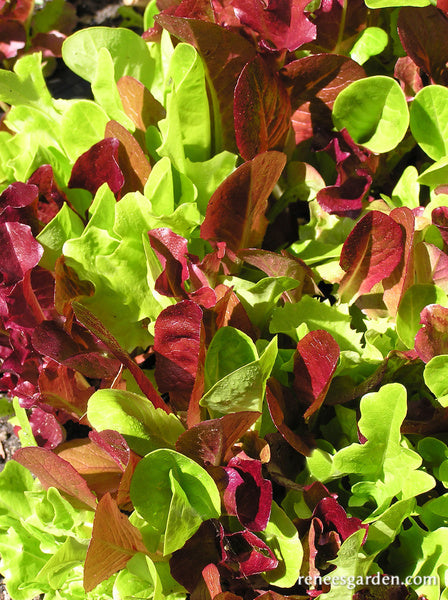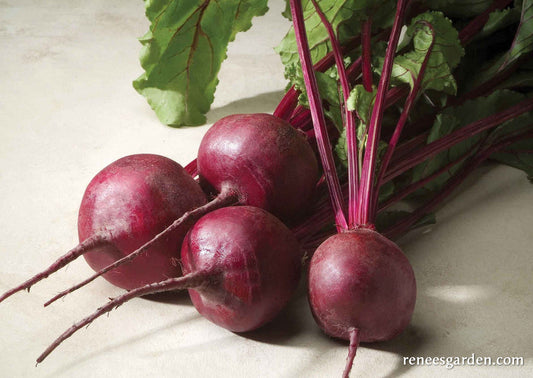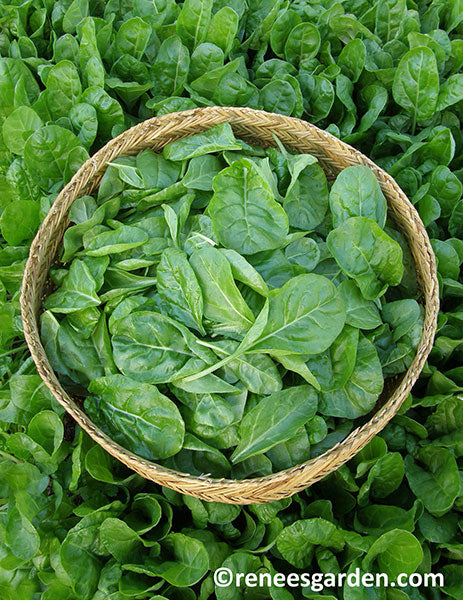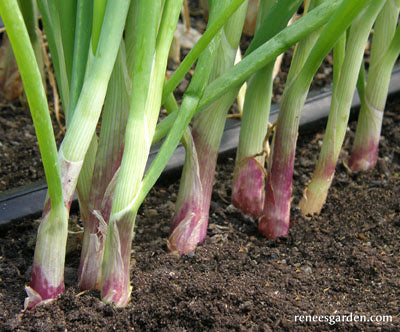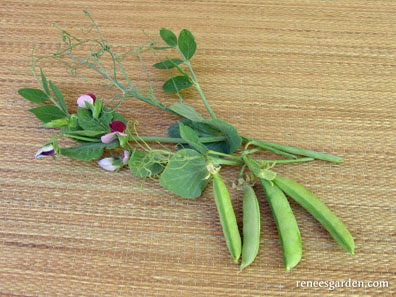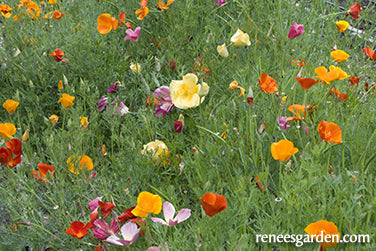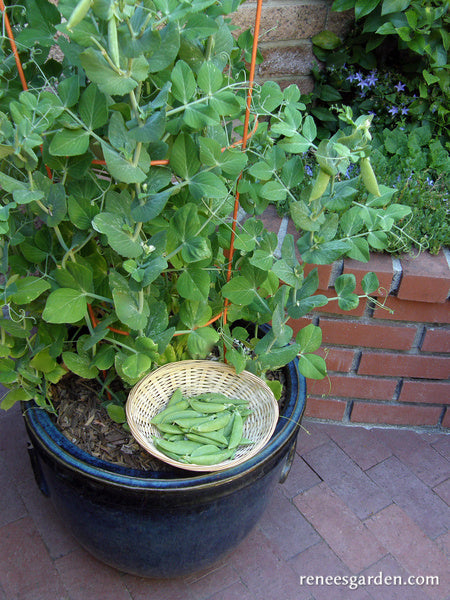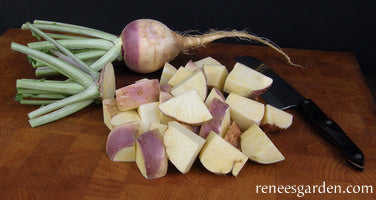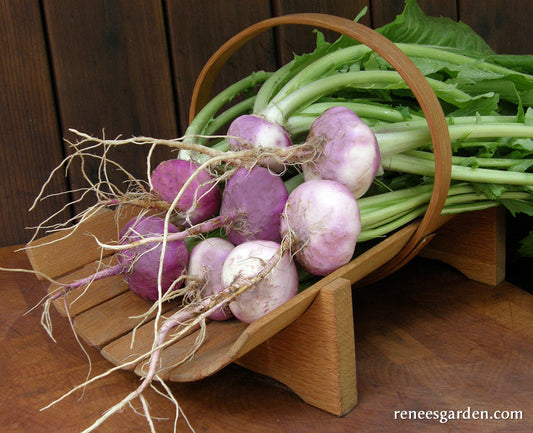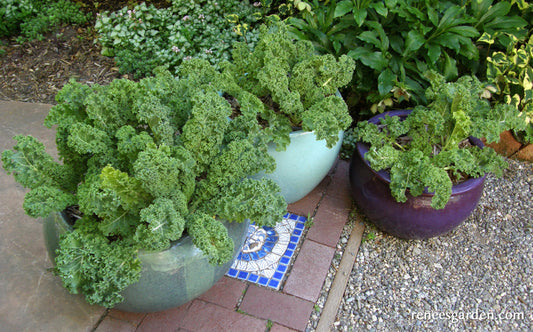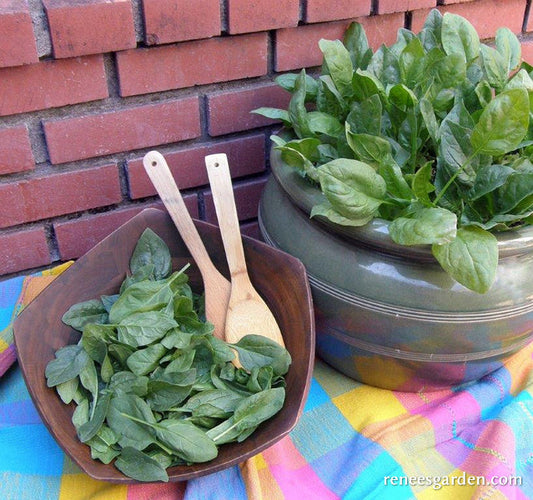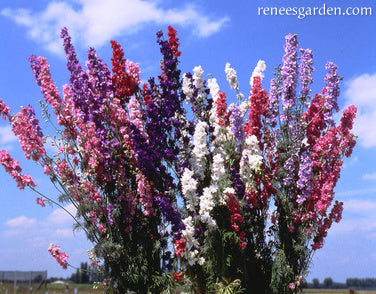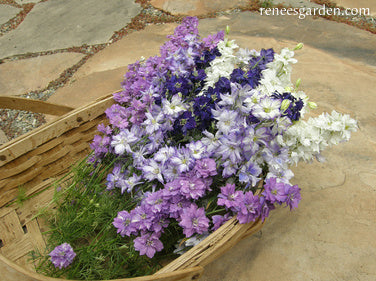Seeds For Fall Gardens
Seeds For Fall Gardens
In cold winter areas: plant mid-summer. In mild winter areas: plant mid-summer/early fall.
-
Five Color Radish Mix Garden Party
START SEEDS OUTDOORS
In early spring as soon as ground can be worked, sow radish seeds in well-worked, fertile soil in full sun. Space seeds 1 inch apart in wide rows 6 inches apart. Keep soil evenly moist and well weeded. If first sowing comes up unevenly, replant right away. Sow in late summer for a fall crop.
GROWING NOTES
Sow this quick cool season crop wherever you intend to plant heat lovers later. Radishes thrive with crisp flesh and mild flavor when given consistent moisture. Sow small amounts a week apart to mature in warm but not hot weather. Thin quick-growing seedlings early to 2 inches apart so roots have room to size up. Protect radishes with floating row covers if marauding birds or flea beetles that chew holes in the leaves are a problem.
HARVEST AND USE
Pull radishes when young round roots have reached the size of large marbles. If weather turns hot, harvest, cut off tops and store in fridge. Radish flavor is mildest in cool weather, spicier in hot conditions. Picked young and tender, this appealing five color mix makes crispy snacks, attractive appetizers, and adds flavor and crunchy texture to salads. Especially delicious sliced and tossed with a sesame or miso flavored dressing.
Regular price $3.99Sale price $3.99Unit price / per -
Farmers Market Lettuce Blend Sweet Greens & Reds
START SEEDS OUTDOORS
In cool early spring weather, sow seeds in finely worked soil in full sun. Shake seeds from the palm of your hand, broadcasting them about 1/2 inch apart over the entire seedbed or in wide rows, and cover lightly and evenly with 1/4 inch of fine soil. Firm soil gently and water with a fine spray. Keep seedbed evenly moist. Make small successive sowings until summer weather turns hot for a constant supply. Plant again in late summer for fall harvesting.
GROWING NOTES
Mixed lettuces thrive in mild weather with consistent moisture. To extend the sowing season into hot weather, sow in light shade or erect a canopy of loosely woven shade cloth over the bed. Birds are often attracted to tender young seedlings, so protect them if necessary.
HARVEST AND USE
To harvest by the “cut and come again” method, wait until plants are 4 or 5 inches tall. Cut as much lettuce as you need, using scissors to shear off a patch of leaves 1 to 2 inches above the soil level. Water well and fertilize lightly and plants will regrow for several more cuttings. Dress with a simple vinaigrette to enjoy the sweet flavor and juicy texture of these delicate young leaves at their best.
Regular price $2.99Sale price $2.99Unit price / per -
Roasting Beets Sweet Merlin
START SEEDS OUTDOORS
In early spring, when danger of hard frost is over, sow seeds in well-worked, fertile soil in full sun. Sow seeds 1 inch apart and 1/2 inch deep in rows 8 inches apart, or broadcast thinly for bed planting. Firm soil well over these irregularly shaped seeds to ensure good germination.
If first sowing germinates unevenly, plant more seed as seedlings will catch up fast. Carefully thin young seedlings to 3-4 inches apart so individual beets have room to size up.
GROWING NOTES
For best quality beets, sow seeds before midsummer heat and again in early fall. Keep soil evenly moist throughout the growing season. Be sure to thin beet seedlings carefully several times as they grow best when given enough room.
HAREVST AND USE
Harvest mature beets when at least several inches in diameter or size them up even bigger. Cut off the tops and reserve. Wash the roots, wrap in foil and then roast to perfection in a preheated 350° F oven until tender when pierced—takes at least an hour, depending on your oven. Cool, peel, slice and enjoy with butter and chopped fresh herbs. Or simply peel, slice and add roasted beets to salads. Steam the tender beet tops for tasty and nutritious greens.
Regular price $4.39Sale price $4.39Unit price / per -
Tender Chard Special Baby Leaf
BEST TO START DIRECTLY OUTDOORS
Beginning in early spring, sow seeds in finely worked soil in full sun. Shake seeds loosely from your hand, broadcasting about 1 inch apart over the entire seedbed or in wide rows, and cover lightly and evenly with 1/4 to 1/2 inch of fine soil. Firm soil gently and water in with a fine spray, then keep seedbed evenly moist. For a constant supply, makes successive sowings every three weeks until summer weather turns really hot. Plant again in late summer for fall harvesting.
GROWING NOTES
For best flavor, baby leaf chard needs consistent moisture and mild weather. Birds love tender young seedlings,so protect them as necessary with netting or floating row covers. This attractive edible will also grow well in pots at least 18 to 20 in. across to snip as needed for salads or stirfry.
HARVEST AND USE
To harvest by the “cut and come again” method: when plants are 4 to 5 in. tall, cut as much as you need, by using scissors to shear off leaves 1 to 2 in. above the soil level. Water well and fertilize lightly and plants will regrow for several more cuttings. These tender, crisp and juicy baby leaves are delicious in fresh salads. Or stirfry, braise or sauté very quickly for healthy, tasty greens.
Regular price $3.69Sale price $3.69Unit price / per -
Heirloom Salad Onions Italian Scallion
EASIEST TO START OUTDOORS
Plant seeds throughout cool spring weather and again in mid to late summer for fall harvests. Sow seeds in well-worked, fertile soil in full sun, spacing 1 inch apart in rows 8-10 inches apart, or broadcast thinly for bed planting. Plant 1/4 inch deep and firm soil well over seeds. Keep soil evenly moist while awaiting germination. Thin young seedlings to 2 inches apart, and enjoy the tender thinnings in spring salads.
GROWING NOTES
These baby salad onions take up little garden space, so tuck a row around beds of lettuce, spinach or radishes. Make several plantings a month apart to have a constant supply for spring and summer meals. Prepare soil well with lots of aged manure or compost before planting. Keep evenly moist and weed carefully when plants are young. Mulch well to conserve soil moisture and suppress weed growth.
HARVEST AND USE
To get the most out of your crop, use tender, mild-flavored early thinnings in salads. Continue thinning out seedlings gradually so plants stand an inch or two apart. Harvest as needed when the stems are ¼ to ½ inch in diameter and the tiny immature bulbs reach just 1/2 to 1 inch in diameter. Crunchy, full-flavored Italian baby salad onions are especially delicious in any green or potato salad, or in any recipe that calls for scallions or mild tasting onions.
Regular price $2.99Sale price $2.99Unit price / per -
Lawn & Patio Heirloom Alyssum, Carpet of Snow
(Lobularia maritima)
Old-fashioned favorite with sweet, meadow-like fragrance. Tiny, pure white blossoms cover mounding plants, looking just like snow in the summertime. Attracts many beneficial insects and pollinators.Regular price $2.29Sale price $2.29Unit price / per -
Lawn & Patio Larkspur 'Giant Imperial Mixed Colors'
(Consolida ambigua)
An old-fashioned favorite in cottage gardens with graceful flower spikes of pink, rose, purple, and white. Long lasting as a cut flower and an excellent choice for dried flower arrangements.Regular price $2.29Sale price $2.29Unit price / per -
Lawn & Patio Heirloom Alyssum, Royal Carpet
(Lobularia maritima)
Spicy-scented blossoms on dense, mounding plants form a pastel carpet of color all season. Perfect accent for planters or between paving stones. Attracts pollinators.Regular price $2.29Sale price $2.29Unit price / per -
Tall Snap Peas Magnolia Blossom
START SEEDS OUTDOORS
In early to mid-spring, plant peas in full sun in well-worked, fertile soil. Sow seeds 1 inch deep and 3 to 4 inches apart in wide rows or bands 3 inches across, spacing the rows 2 feet apart. Provide supports for these climbing 5-8 foot vines at planting time. Protect from marauding birds with netting or floating row covers if necessary. Cold and wet early spring weather may affect germination, so if first sowing doesn’t germinate evenly, replant right away as new seedlings catch up quickly. Sow again for a fall crop about 2 1/2 months before first expected fall frost.
GROWING NOTES
These are hypertendril peas, meaning that the vines will produce long twirling tendrils in place of some leaves. This trait helps increase air flow so there is less disease potential. Use netting or wire trellis to support these heavy bearing tall vines for easy picking. Keep pea vines well weeded and watered and mulch to conserve moisture. Water at the base of the plants to avoid mildew.
HARVEST AND USE
Harvest only when peas are mature and round in the thick walled, juicy pods for the best developed flavor. Savor their sweet crunch fresh from the garden (kids especially love them!) as a snack or slice into salads. Pick pods regularly and you’ll have longer production of new ones. To cook quickly, pull strings from pods and sauté in a little oil just until pods turn a deeper green color.
Regular price $4.39Sale price $4.39Unit price / per -
Lawn & Patio Heirloom California Poppy, Mission Bells Mixed Colors
(Eschscholtzia californica)
Delicate, silky flowers in shimmering colors are held high on slender stems. Very early to flower and water wise. Reseeds in mild climates.Regular price $2.29Sale price $2.29Unit price / per -
Lawn & Patio Heirloom California Poppy, Orange
(Eschscholtzia californica)
State Flower of California. Water wise and tolerant of poor soil, California poppies have feathery blue-green foliage and silky, bright orange flowers on sturdy stems. Reseeds in milder climates.Regular price $2.29Sale price $2.29Unit price / per -
Lawn & Patio Pansy Swiss Giants Mixed Colors Seeds
(Viola wittrockiana)
This dependable beauty never goes out of style. Large, colorful blooms bear the distinctive pansy ‘face’ all season long. Pansies shine in cooler weather.Regular price $2.49Sale price $2.49Unit price / per -
Bonus Pack A Rainbow of California Poppies
START SEED DIRECTLY IN THE GARDEN
Sow seeds directly in fine textured, well drained soil in full sun as early in spring as the ground can be worked. Plant as early as possible in spring, as poppies can handle light frost and bloom best and longest when plants get a good start in cool weather.
Except in very poor soil, these California poppies will flower readily with no added fertilizer.
Sprinkle seeds thinly, cover or rake in lightly, 1/4 inch deep, and firm soil gently. Be sure to keep the soil moist while awaiting germination and when seedlings are small. For best results, thin well-established seedlings to a final spacing of 6 to 8 inches apart so plants have room to grow, develop and bloom.
In Mild Winter Climates, where ground does not freeze hard, poppies can also be sown in late fall to over-winter for spring bloom. Be sure to protect fall-grown seedlings from slugs, snails and marauding birds.
GROWING NOTES
When mature, poppy plants can handle dry conditions, but will thrive and always bloom much longer if watered regularly. Poppies are lovely cut flowers if brought indoors just as buds begin to open. At season's end, allow spent flowers to form pods and drop seed if you want poppies to self-sow.
Regular price $9.99Sale price $9.99Unit price / per -
Container Snap Peas Little Crunch
START SEEDS OUTDOORS
In early to mid-spring, plant peas in full sun in well-worked, fertile soil. Sow 1 in. deep and 3 in. apart. Protect from marauding birds with netting or floating row covers if necessary. Wet, cold early spring weather may affect germination, so if first sowing doesn’t germinate evenly, replant right away: new seedlings catch up quickly. Sow again for a fall crop, several months before fall frosts.
FOR CONTAINERS
Plant in pots at least 15-18 in. in diameter and 12 in. deep. Sow 1 in. apart, 1 in. deep. When seedlings are 2-3 in., thin to 3 in. apart, so each little vine has growing room. Provide 2-3 ft. tall supports or a short trellis at planting time. Mulch to conserve moisture. Feed with all-purpose fertilizer every 2-3 weeks. If it gets hot, check and water containers daily; otherwise, water when the top inch of soil is dry. Water at base of the plants to avoid mildew.
HARVEST AND USE
Harvest only when peas are mature and rounded in the thick-walled, juicy pods for the best developed flavor. Savor their sweet crunch fresh (kids especially love them!) as a snack or slice into salads. To cook quickly, pull strings from pods and sauté in a little oil just until pods turn a deeper green color.
Regular price $4.69Sale price $4.69Unit price / per -
Lawn & Patio Bachelor's Button Seeds Polka Dot Mixed Colors
(Centaurea cyanus)
Also known as cornflowers, these easy-to-grow favorites bear a profusion of cheerful, button-sized blooms in a mixture of bright colors. Outstanding cut flower retains color when dried.Regular price $2.29Sale price $2.29Unit price / per -
Lawn & Patio Cilantro Slow Bolt
Improved variety that’s slower to bolt in warm weather for a longer harvest time. Use both seeds and leaves to add distinctive flavor to a wide variety of dishes. Essential for Asian and Tex-Mex cooking.Regular price $7.89Sale price $7.89Unit price / per -
Lawn & Patio Heirloom Hummingbird and Butterfly Mix
Lovely annual flower mix that provides pollen and nectar for pollinators. Contains: Sunflower, Nasturtium, Zinnia, Calendula, Love-in-a-Mist, Sunset Flower, Scarlet Flax, Dwarf Coneflower, Indian Blanket, Larkspur, Lemon Mint, Spurred Snapdragon and Alyssum.Regular price $7.89Sale price $7.89Unit price / per -
Classic Rutabagas Improved Helenor
START SEEDS DIRECTLY OUTDOORS
Mild Winter Areas: In midsummer, sow seeds in well-drained garden soil in full sun. Sow 2 inches apart and 1/2 inch deep in rows 12 inches apart. When several inches tall, thin seedlings to stand 6 inches apart, so roots have room to size up. If spring sowing is your only option, sow seed as soon as soil can be worked, and harvest as soon as roots size up to avoid them becoming fibrous.
Cold Winter Areas:
Plant as above in early to midsummer, about 12 weeks before first fall frost, so roots will finish in cooler autumn weather. Flavor gets sweeter after a few frosts; mulch to protect roots from freezing.GROWING NOTES
Rutabaga reach top quality and flavor maturing in cool weather, so are best planted midsummer for a fall crop. For best quality roots, keep plants consistently moist and well weeded. Use floating row covers or fine insect netting to keep out pests while seedlings are young.
HARVEST AND USE
Harvest as needed when roots reach tennis ball size; pull or dig out roots carefully. Rutabagas are delicious peeled, then cut in chunks, tossed with olive oil & roasted until tender by themselves or with other root vegetables. Or slice them up to sauté gently in butter, or steam and mash.
Regular price $4.39Sale price $4.39Unit price / per -
Heirloom Turnip Purple Top Milan
START SEEDS OUTDOORS
In early spring, as soon as ground can be worked, sow in well worked, fertile soil in full sun. Space seeds 1-2 inches apart in wide rows 6 inches apart. Cover 1/2 inch deep. Keep soil evenly moist and well weeded. Carefully thin seedlings early to stand 4-6 inches apart, giving them room to size up. Provide consistent moisture.
GROWING NOTES
Make a second spring sowing 10 days later, before summer heat. Protect with floating row covers if marauding birds or flea beetles that chew holes in the leaves are a problem. Sow again mid to late summer for fall harvest.
HARVEST AND USE
Begin harvesting when the turnips reach 2 to 3 inches in diameter. If weather turns unexpectedly hot, pull and store the roots in the refrigerator.
Note: Turnips are always spicier when the weather turns hot. Slice and sauté or steam; use in soups and stews, or (and this is our favorite) just cut them in quarters or large chunks, toss with olive oil, then roast in the oven until tender to bring out their natural sugars. Enjoy the tasty, nutritious green tops steamed or quickly braised.
Regular price $4.89Sale price $4.89Unit price / per -
Container Kale Green Curls
TO START INDOORS
In very early spring, sow seeds in seed starting mix 2 in. apart and 1/2 in. deep. Keep moist and provide a strong light source until seedlings are well-established, then plant outdoors 6 in. apart.
PLANTING IN CONTAINERS
Use pots a minimum of 15-18 in. in diameter and 12 in. deep and start with fresh potting mix. Sow groups of 2-3 seeds 6 in. apart, 1/2 in. deep. Keep evenly moist. When large enough to handle, thin to leave one seedling per group, so plants have room to mature. Keep mulched to conserve moisture. Feed with high nitrogen fertilizer every 2-3 weeks. If it gets hot, check and water daily; otherwise, water when top inch of soil is dry.
GROWING NOTES
Kale tastes best in cool weather and frost actually enhances color, flavor and sweetness. Plant in early spring and again in late summer/early fall.
HARVEST AND USE
Begin harvesting outer leaves when plants have at least 6 leaves. Vitamin and antioxidant rich kale is tender and delicious in fresh salads, especially with sliced fruit and/or nuts. Use in smoothies, soups, stews and sautés; or braise with garlic and olive oil. Pull and discard when plants begin to bloom as leaves of flowering stalks get tough and bitter.
Regular price $3.99Sale price $3.99Unit price / per -
Container Baby Leaf Spinach Little Hero
CONTAINER PLANTING
Plant in early spring when danger of hard frost is over. Use a pot at least 15-18 in. in diameter and 12 in. deep, and start with fresh potting mix. Sow seeds 2 in. apart or simply broadcast seeds thinly, aiming for 2 in. spacing. Cover with 1/2 inch of potting mix and firm soil well over seeds. If first sowing germinates unevenly, plant more seed as seedlings will catch up fast.
GROWING NOTES
Birds love tender young seedlings, so protect as necessary with netting or floating row cover. Sow again in late summer for a fall crop. Keep spinach well watered and weeded and fertilize every few weeks and especially after harvesting.
HARVEST AND USE
To harvest by the “cut and come again” method: when plants are 4 to 5 in. tall, cut as much as you need, by using scissors to shear off leaves 1 to 2 in. above the soil level. Water well and fertilize lightly and plants will regrow for several more cuttings. Little Hero’s tender, baby leaves are delicious in fresh salads with additions like thinly sliced sweet onions, sliced radishes, thin wedges of apple or orange, toasted nuts, chopped scallions, crispy bacon bits, hard-cooked egg quarters and grated cheese. Or stirfry, braise or sauté very quickly for healthy, tasty greens.
Regular price $3.99Sale price $3.99Unit price / per -
Lawn & Patio Cut Flowers 'Bouquet Mixture'
An ideal mix of annuals for fresh summer bouquets in a wide array of colors, shapes and sizes. The mix contains Bachelor’s Button, Calendula, Aster, Larkspur, Gloriosa Daisy, Snapdragon, Shirley Poppy, Clarkia and Zinnia.Regular price $2.49Sale price $2.49Unit price / per -
Heirloom Imperial Larkspur French Alouette
HARDY ANNUAL
Spring/summer bloom
Frost hardyBEST TO PLANT DIRECTLY IN THE GARDEN
In mild winter climates, sow seeds in late fall to germinate and form deep roots over the winter for a long spring bloom.
In cold winter areas, sow seed as early in spring as soil can be worked as larkspur can handle frosts and blooms best when started in cool spring weather. Sow seeds 1 inch apart in well-drained soil in full sun. Cover 1/2 inch deep, firm soil and keep moist. Be patient; germination takes 14 to 21 days. After seedlings are well established, about 2 or 3 inches tall, thin to 8 inches apart to allow for good air circulation and discourage disease. Keep plants well watered and weeded for best performance.
GROWING NOTES
Sow seed early when weather is still cool to get sturdy plants that will provide many weeks of bloom. Cut flowering stalks before individual florets begin to drop for graceful indoor bouquets, or air-dry indoors for everlasting arrangements. Larkspur will continue to bloom well into summer if faded flowers are removed.
Regular price $2.99Sale price $2.99Unit price / per -
Bouquet Larkspur Singing the Blues
HARDY ANNUAL
Spring/summer bloom
Frost hardyBEST TO PLANT DIRECTLY IN THE GARDEN
In mild winter climates, sow seeds in fall to germinate and form deep roots over the winter for a long spring bloom. In cold winter areas, sow seed as early in spring as soil can be worked. Larkspur can handle frosts and blooms best when plants get a good start in cool spring weather. Sow seeds 1 inch apart in well-drained soil in full sun. Cover 1/4 inch deep, firm soil and keep seed bed moist. Be patient; germination takes 14 to 21 days. After seedlings are well established, about 2 or 3 inches tall, thin to 10 inches apart to allow for good air circulation and discourage disease. Keep plants well watered and weeded for best performance.
GROWING NOTES
Sow seed early, when weather is still cool, to get sturdy plants that will provide many weeks of elegant and beautiful flowers. Cut flowering stalks before individual florets begin to drop for graceful indoor bouquets or air-dry indoors for everlasting arrangements. Larkspur will continue to bloom well into summer if faded flowers are removed. Agrostemma, cornflowers and Bishop’s Lace are classic cutting garden companions for larkspur.
Regular price $3.69Sale price $3.69Unit price / per



